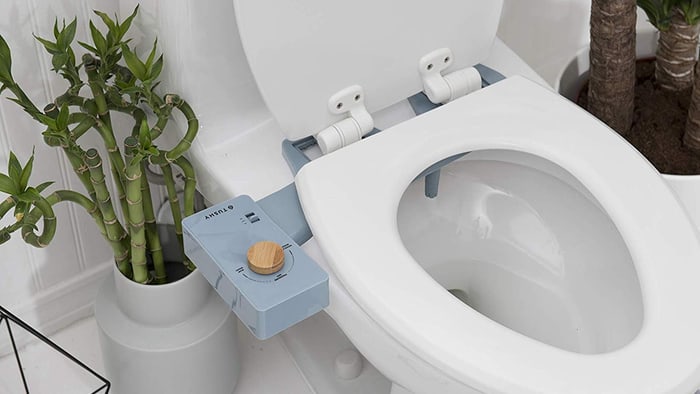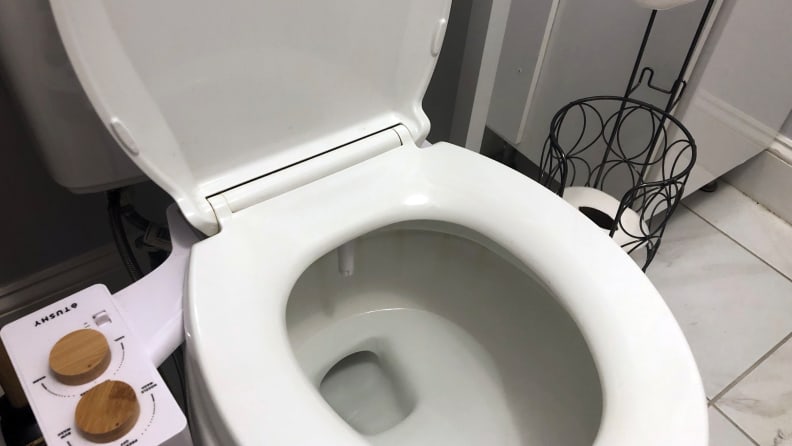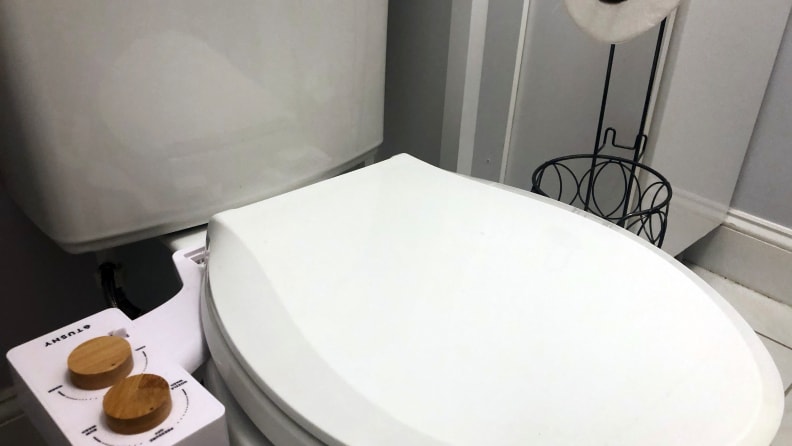 Credit:
Tushy
Credit:
Tushy
Products are chosen independently by our editors. Purchases made through our links may earn us a commission.
If you've lived in North America your entire life (like me), your bathroom ritual probably involves a lot of toilet paper. In fact, you may not even be familiar with a bidet unless you've traveled to places like Europe or Japan.
So what is a bidet? For those who don't know, a bidet is a plumbing fixture that uses a stream of water to clean your nether regions after doing your business.
They're so common in other parts of the world though, you can't help but wonder, why they’re just now becoming popular in the United States.
One particular brand that’s been taking the bidet industry by storm is Tushy, which launched in 2015 and sells two non-electric bidet attachments—the Classic ($129) and the Spa ($159) as well as a portable bidet ($29).
Despite this surge in popularity, there remains a stigma surrounding the hygiene device, one that most Americans aren't willing to shed, in part because of their time-honored devotion to toilet paper. The question comes down to: is it really worth switching from TP, and opting to wash instead of wipe? To answer this burning question, I tested out a Tushy bidet for a few months (in the name of service journalism, of course). Keep reading as I try to settle the great bidet vs. toilet paper debate once and for all.
Which cleans better?

I tested the Tushy bidet over a 3-month period.
During my time spent testing, I found that bidets provide a more thorough clean than toilet paper. After going number two, the targeted stream of water cleanses away any leftover post-poop residue, rather than smearing it around with toilet paper. We, as a society, could say goodbye to skid marks and dingleberries forever, people!
As the makers behind Tushy put it, “If a bird pooped on you, would you wipe it off with dry paper or would you wash it with water?” The answer is a no-brainer, I hope.
Which is more hygienic?
The beauty of the bidet is that by washing your rear-end rather than wiping it, you're reducing the risk of any dreaded hand-to-poo contact. While I still like to dry with a square or two of toilet paper, you may not even feel the need to wipe at all. Since we're constantly touching dirty things every day, a bidet helps eliminate the need to put your hands anywhere near your booty-hole, thus helping you spread fewer germs after a trip to the bathroom (please wash your hands, regardless).
One hygienic feature about the Tushy in particular is the “nozzle wash” option, which self-cleans the outside of the nozzle by rinsing it with water.
Bidets attachments like the Tushy screw on underneath your existing toilet seat, so any mess from your butt-washing experience goes right into the bowl (no need to worry about poop crumbs going flying). And if you're turned off at the thought of using "toilet water" to clean yourself—the water actually comes directly from the faucet supply behind your toilet—the same as the water from your sink.
Which is better for the environment?
While bidets still use water, meaning they're not entirely zero-waste, the good news is that you'll be using significantly less resources compared to relying on toilet paper alone. According to Tushy, it takes 37 gallons of water to make a single roll of toilet paper, while a Tushy bidet uses around 1.3 gallons of water per week, or about an eighth of a gallon per use (not to mention the carbon emissions produced by manufacturing and transporting toilet paper every year).
Adding a bidet to your household conserves both trees and water, lowering your overall environmental impact quite substantially.
Which is cheaper?
Since bidets can help cut down your toilet paper usage, they're also a cost-effective investment to make in the long run. On average, Americans spend $70 to $120 per year on toilet paper, while tap water for a bidet costs just a fraction of a cent per gallon.
The basic Tushy model costs $129 with free shipping on any order of $49 or more, meaning you’ll recoup your initial investment in a little over one year's time.
Which is easier to use?

The Tushy comes with everything you need (minus tools) for installation.
Once installed, the Tushy bidet is extremely easy to use—all it takes is a twist of the oval-shaped knob to turn the water on, and you're in business. While not completely hands-free, bidets like the Tushy are highly accessible compared to wiping with toilet paper, especially for those with limited mobility. Another bonus is that in all likelihood, you won't have to deal with nearly as many clogged toilets!
The installation process on a bidet is a bit trickier. Personally, it took me about an hour to install the Tushy—not the ten minutes promised on the box—because I ran into a number of hurdles while getting it connected to the water supply.
Namely, my toilet seat is designed with plastic-quick release mounts that required an additional step, and also a trip to the hardware store to buy longer screws. Despite following the instructions, my Tushy bidet was still a bit loose on my toilet seat—I definitely recommend having a screwdriver and wrench on hand to help you get it attached.
So, Tushy or TP?

The Tushy Spa bidet, in all its glory.
If I haven't made my love for the bidet obvious, let me be clear: it's clearly a superior option to toilet paper, and will totally revolutionize your whiz palace. It's also better for your wallet and for the environment in the long run. Who wouldn't want to step up their personal hygiene, while saving the planet in the process?
